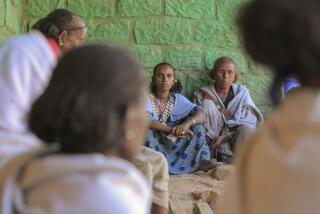Starving Zambians See Little Hope for a Filling Future
- Share via
KOOMA, Zambia — In the village of Kooma, people compete with baboons and birds for nuts and wild fruit to survive.
“We share with animals,” said Elliot Magoloi, 68. “It’s a shame.”
His face was gaunt. Frayed blue coveralls hung from his body.
Drought has left as many as 14.4 million people facing possible starvation, according to United Nations estimates. Here, in Zambia’s southern province, a flat landscape of sandy soil and crackling, dry yellow grasses, the crisis has hit especially hard.
Magoloi’s daughter-in-law, Maureen Kola, 22, sat on a straw mat nearby with her five children. She fingered the rough shell of a wild mungongo nut, put it on a triangular rock and smashed it with a round, smooth stone. The thin porridge it would produce was the only food in the village.
The children cry, she said, “because of the hunger.” She pointed at a skinny dog. “That means there is nothing.”
In impoverished Zambia, where nearly 30% of the people are going hungry, some argue that government policy has made things worse.
Zambia’s government decided in August to reject donated corn from the United States because some of it was genetically modified. The government said it worried about possible side effects, even though U.N. agencies certified the food as safe.
But the United States is by far the largest donor in response to the southern African hunger crisis. Aid organizations said they are scrambling to find alternatives.
“The problem is finding it fast enough,” said Richard Ragan, the World Food Program’s representative in Zambia.
In Kooma, a village of thatched-roofed mud huts, Cryson Mutema is bitter about the debate going on in the capital, Lusaka, 340 miles north.
Mutema, 38, said he had heard radio reports of President Levy Mwanawasa’s fears that genetically modified food could be poisonous.
“He doesn’t want? But we want. He’s eating, all day. He is satisfied. Here, we are hungry. Here, we go starving,” Mutema said.
His 3-year-old son sat at his feet. The listless child’s enormous eyes stared but focused on nothing.
The villagers said this year has been especially hard because a cattle disease wiped out much of the area’s livestock. In the past, they could have sold a cow to buy food.
Cattle, a sign of status, are used to perform the hard labor of clearing fields. It is a task that this year must be done by hand on empty stomachs.
The wooden doors of several huts down the road are bolted with long sticks. The owners have gone 25 miles west in hopes of eating better in Livingstone, a resort town.
Even the local schoolteacher has left. The villagers couldn’t pay her, so now children spend their days at home. Hunger leaves them too tired to play.
In Maunga, about 12 miles away, relief supplies had arrived. Women in headscarves and print skirts of fuchsia and gold, and men in threadbare shirts sat quietly in front of the village school waiting for their names to be called to collect sacks of corn distributed by the international relief group CARE.
For many, it was the first corn they had had all year. They smiled when they talked about once again making nchima, a cornmeal mush that is their traditional food.
Older couples walked off carrying the heaving sacks between them. Some carted the grain away by wheelbarrow. Young women balanced sacks on their heads and glided into the bush.
But in Kooma, home to about 300 people, a small group sitting in a packed sandy yard talked about a life of hunger.
“I spend my days sitting because I can’t do anything. I just want to sleep,” Magoloi said.
Some food relief arrived later, but life remains difficult.
The drought so devastated the village’s corn, its staple crop, that villagers did not bother building grain storage sheds. There was nothing to store.
As planting season begins this year, Magoloi and his neighbors say they don’t know how they will muster the strength to sow the fields or find the money to buy seed.
“If I’m hungry, I feel like I have no hope,” Magoloi said. “I feel blue to my heart.”
More to Read
Sign up for Essential California
The most important California stories and recommendations in your inbox every morning.
You may occasionally receive promotional content from the Los Angeles Times.













